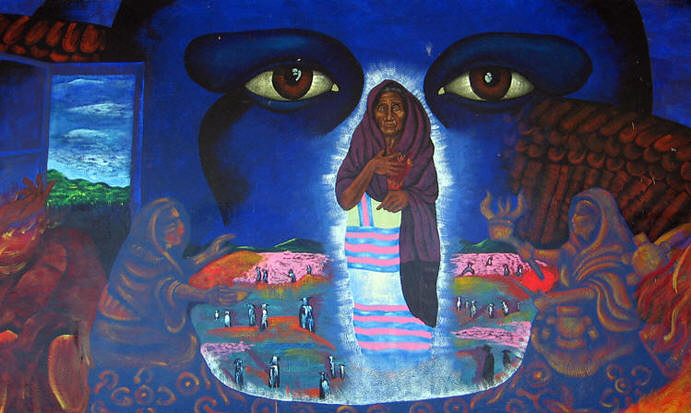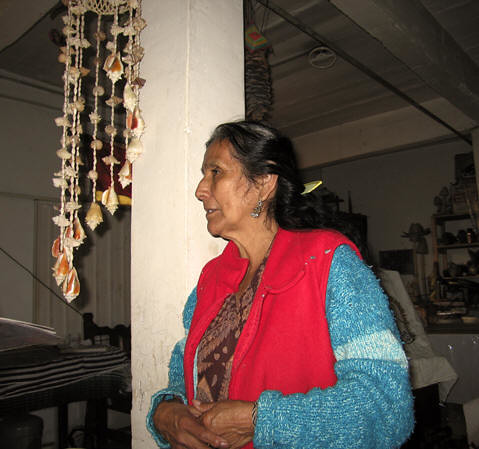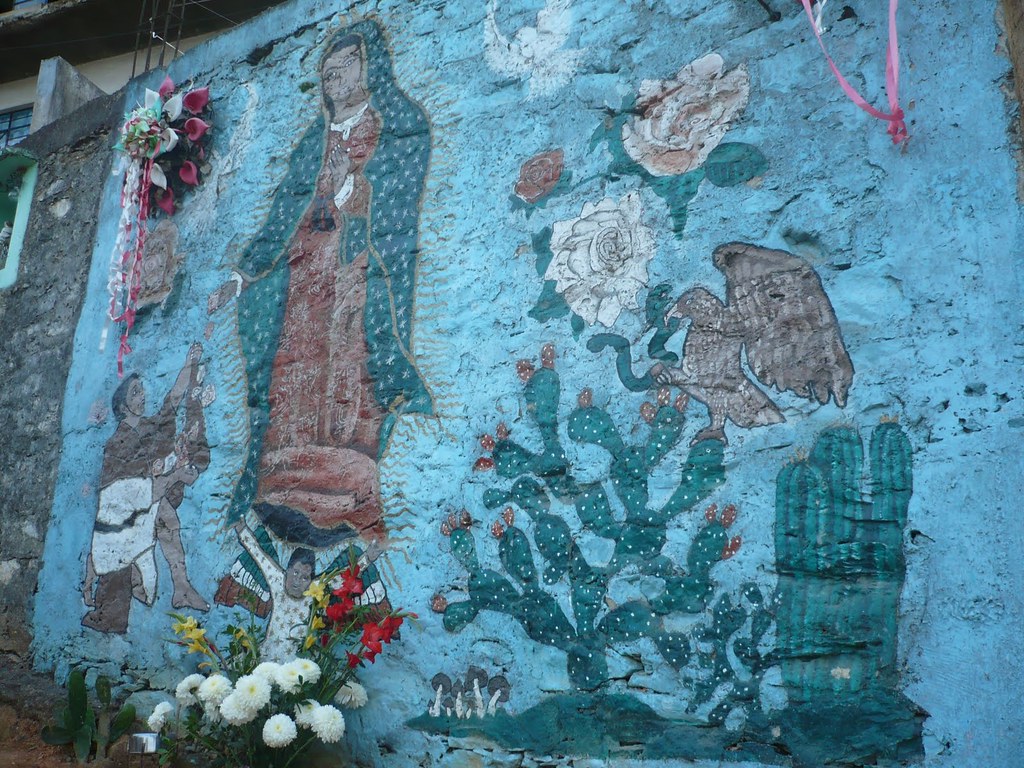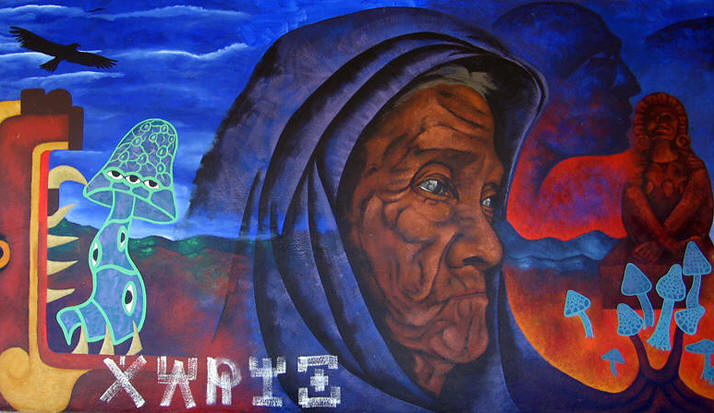
Castaneda je bio (dobar) fiction, ovo je for real.
Svijet šamana (curandero) nije romantičan - liječenje, mir, ljubav i prošli životi ali i otmice djece i obredi žrtvovanja.

Doña Julia Julieta Casimiro
by

Grandmother Julieta, in her tradition huipil (embroidered female Oaxaca dress), doing a cleansing prayer on Julia, Grandmother Maria Alice’s daughter.
The council meets every six months, hosted by one of the Thirteen Grandmothers. The hosting grandmother can share her culture, her way of life, and her way of healing. If the wisdom of the grandmothers were combined, humanity could be re-educated to perceive each human being in a new way, within his or her context, with respect to both physical and spiritual health. In May of 2006, the Grandmothers visited Mazatec grandmother Julia Julieta in Oaxaca.
This interview brings us closer to the essence of Doña Julia Julieta’s personality, and allows us to see who she is, the process of her growth as a wise woman, a chota chine, “the one who knows.” She talks to us about the spiritual world as a guide, a curandera, a shaman, and describes what she has done over the course of her life, that is, the part she has dedicated to working in ceremony with the niños santos, or sacred mushrooms. She speaks of her experiences and those of some of her patients, in other words, the importance of her work for humanity.
In my opinion, this interview has great value for these times, when we have become desensitized to human pain, when we have lost inner values such as love, peace, self-respect, and respect for all living things, when it is so necessary and urgent to become aware of our responsibility as human beings toward our planet.
Doña Julia Julieta Casimiro was born in the city of Huautla de Jiménez, Oaxaca, in the neighborhood of Agua Abundante, on April 2, 1936, the daughter of María Petra Estrada and Maclovio Casimiro. Her eight brothers and sisters are Herlinda, Genario, Federico, Pablo, Teodora, Concepción Guadalupe, Angélica Juliana, and Angelina Cutberta. At an early age Julia Julieta began primary school where she learned how to read and write. Later on she left school to start working, helping her mother with kitchen duties. This is how her first years passed by. At the age of 15 she met the man who would be her husband.
After a courtship of two years, she was married to Lucio Isaías Pineda Carrera on December 31, 1954. They had 10 children: Jorge Adalberto, Lourdes, Jacinto Librado, Jesuita Natalia, María de los Ángeles, Magdalena, David Lucio, Eugenia, Jazmín, and Omar.
This is one part of the story of Doña Julia Julieta Casimiro (now a widow), a woman whose students have spread her fame as a great spiritual guide around the world. She is regarded as such by all those who have received an answer to their inquiries. She cures both physical and emotional diseases, utilizing niños santos to those ends.
There are many in the society who shape a vision of the cosmos; to grow and develop as a wise woman it is important to count on the support of all family members in order to assume a position of authority in such practices. She started on the path to becoming a wise woman with her marriage to Don Lucio Isaías Pineda Carrera. He was her biggest support, and it is through him that she obtains her wisdom, because Don Lucio’s family on his maternal side, for many generations, have been wise men and women. Genealogically and culturally they have been powerful shamans, guides, curanderos, and prophets, known throughout the entire Mazatec region. Don Lucio was the son of Doña Regina Carrera Calvo and Professor Librado Pineda Quiroga. They had eight children: Victor, Joaquín, Alejandro, Eleazar, Gonzala, Lucío Isaías, Celia Julieta, and Joel.
Mama Julia Julieta tells us that after observing all the official rites and traditions of marriage she joined this family, who gave her much of the knowledge that she would later contribute to the world.

Traditional Mazatec women greeting The Grandmothers in Oaxaca, Mexico.
Doña Julia Julieta Casimiro
It all began one day shortly after I was married. My mother-in-law, Doña Regina Carrera Calvo, said to me, “I want to teach you about ndi shito, sacred mushrooms.” Then one night, with my husband, mother-in-law, and me in attendance, the ceremony began, during which she prayed and commended us to the Almighty. After the prayers we ate the niños santos in a safe and pleasant atmosphere, and a little while later, 30 minutes more or less, my trip began. I tell you, it was something great and marvelous. I saw the earth in its round shape making very slow turns. Everything I saw was very pretty. I saw some big palm trees that moved from side to side and gigantic bells like the ones in the tower of the church in Huautla de Jiménez, Oaxaca. I saw how they moved and what they sounded like; they sounded like this, pom pom pom. The truth is I liked it, and it was on this path that I began my way of life.
Other teachings followed, given to me with love by my mother-in-law. My mother-in-law was a great wise woman. Of course she was, the whole family on her mother’s side were very good shamans and seers. They knew; they were very wise people. My mother-in-law spoke to me about her mother, señora Cecilia Calvo, about her great-aunts Gregoria Calvo and Natalia Calvo, and about her sisters Aurelia Carrera and Martina Carrera.
I believe that in order to dedicate oneself to this profession one must be very brave, very honest, and very humble. One’s heart must be clean for things to turn out well. In truth that’s how my work has been; for that reason people believe in it. Meanwhile I’ll keep going, because God is the one who gives me the strength to keep going.

Iglesia de la Virgen de los Remedios (The Church of the Virgin of Remedies), Huautla de Jiménez, Oaxaca, Mexico.
My work began in earnest with foreigners, from Europe or the United States, people from Mexico City or other states in the Republic of Mexico. In 1968, huge numbers of people came. At that time, no one liked foreigners, whether from other countries or other parts of Mexico. Strangers were not welcome; they were all hippies with their slogans of peace and love; they were poor. Yes, you felt bad when you saw how they were treated; this was the start of the waves of people searching for one or another alternative way of perceiving reality. It’s with these people that I began working steadily with my husband, working secretly in fact, because it was frowned on to give niños santos to foreigners. That is, we worked against our culture and ran the risk that comes with opening your doors to those who don’t belong to your culture.

Grandmother Julieta’s altar at hom in Huautla de Jiménez, Oaxaca, Mexico.
I’ll describe some of the problems of the patients I’ve worked with. I’ve helped people with emotional problems, who for years had other treatments with no results. I’ve worked with homeopathic doctors. I’ll describe the case of a patient who had been depressed for a long time and who told me that she noticed an improvement after she participated in one of the ceremonies. She said, “I came to be cured because I suffer from chronic depression, and while I was on my trip, I saw my birth as I was passing through the birth canal.” She said, “I wasn’t afraid, I felt secure, because of the imposing personality and spiritual force of Mama Julia. She mediates between different realities, because eating the mushrooms isn’t like anything else; they have a soul as well, and this soul has strength, and that’s what helps us to penetrate to other states and other realities.”

Grandmother Julieta with His Holiness the Dalai Lama at the Tibetan Children’s Village in Dharamsala, India, while attending the International Council of Thirteen Indigenous Grandmothers’ fourth council gathering.
Another one of my patients, a health professional, has described his experience in a conversation:
“The ritual began as usual, at Mama Julia’s house. It was my first experience with mushrooms and the anticipation made me very anxious and afraid. I wasn’t sure what this experience would be like for me. It all began with prayers, invocations, and songs to the Virgin of Guadalupe and to God.
“My first question was what would I feel, how would I know that my trip had started? Mama Julia told me to be calm and that I would simply know.
“After seeing colors and feeling palpitations I began to experience the memory of a past life. At that moment I didn’t know what it was about, there were simply visions. I remembered having been a curandero who wore a bear’s head, and this distinguished me from the rest of the tribe, and the people respected and admired me greatly. In that faraway time, someone had taken the women and children of my tribe, and the people asked me to go and find out who was kidnapping them. As the shaman of the group, I undertook a journey to search for the kidnappers. Along the way I met a very attractive woman and immediately felt ensnared by her.
“She took me to her tribe and introduced me to its chief. At that moment I instinctively realized it was this tribe that was kidnapping the members of my tribe. I decided to investigate more about them, using a shamanistic technique [to trap] them: many months passed before I decided to return to my people. In the meantime this woman taught me many of their arts, their magic, their mysticism, their powers, their ways of healing. I was curious about where they kept those who had been kidnapped, what they did to them, and why they made them captive, and for this reason I decided to stay a little longer. During those months of contact with the tribe, I fell in love with this woman. She loved me but also had a secret relationship with the chief of the tribe. When he realized that I was going around investigating, and that his woman was also attracted to me, he decided to have me killed.
“One day when I was at the river bathing myself, I felt a knife enter my back and I fell down. I felt a great pain between my left shoulder blade and my backbone, I saw women’s feet running away, and everything around me went dark. Once again I was in Mama Julia’s house with a great pain in my back. Mama Julia rubbed my back and in a short time she cured me and the pain disappeared.
“Two years after my experience with Mama Julia, I met a woman with whom I identified. We became friends and she asked me to perform a regression on her. I agreed, and during the regression she began to tell me her story, that she was the member of a clan that kidnapped people to perform very bloody rituals on them. She described someone with whom she had fallen in love, although she had a relationship with the chief of the clan. She told me how that man had been killed. She explained what caused his death, where they had stabbed him, with a wealth of details. I was very surprised to remember and understand my trip with the mushroom. Two years and three months after her regression, we went with Mama Julia to close the circle between the two lives that tied us together.
“At this moment she and I no longer see each other but we understand many things about our present by understanding our past together.”
After people working in the health profession reported their journey experinces to me, I can say that I have added to the knowledge of other human beings. I have been part of their education. I have inspired an interest in healing through spiritualism in other people. These people are my branches. I believe that I have created a school for all those who search for an alternative way to cure their illnesses, and they in turn can help to cure others.
My work has harvested souls, a great achievement for humankind, for all of us who believe that things in the world can be better, if we attempt at every moment to do things well: to show respect, to value what has little value today, to feel proud of our identity, to defend our traditions, to defend our traditional medicine, to love and respect our elders and listen to them with great attention, to teach children to live with respect, peace, and love. The mission of all human beings who achieve consciousness is to take care of themselves and Mother Earth.
Translated by Margaret Carson

First International Council of Thirteen Indigenous Grandmothers, Pheonicia, New York.

Grandmother Julieta Casimiro is a Mazatec elder, curandera, and healer from Oaxaca, Mexico. For more than 40 years, people around the world have come to Julieta for ceremony, healing, and life guidance. She works with people who have AIDS, cancer, emotional diseases, and psychological imbalance. "For the work to go well, I am always invoking
 God," she says. "This way the people
feel well and are also able to express what they are experiencing."
God," she says. "This way the people
feel well and are also able to express what they are experiencing."Doña Julieta Casimiro was born in the city of Huautla de Jiménez in 1936. At an early age Julieta began primary school where she learned how to read and write. Later on she left school to help her mother with kitchen duties and to help care for her eight brothers and sisters. At the age of 15, Julieta met the man who would be her husband and two years later, she married Lucio Isaías Pineda Carrera. They eventually had 10 children.
Grandmother Julieta began exploring her healing gifts when she was 17 years old. Her mother-in-law was a traditional Mazatec healer and taught Julieta about Tenocanacatl, the sacred mushrooms. "Because we don't have money for doctors, we heal ourselves with the mushrooms," Grandmother Julieta explains. "It is believed that God gave the mushrooms to the peasants and to those who could not read in order for them to be able to have a direct experience of Him." The plant medicines helped Julieta gain wisdom and deepen her relationship with God.
The sacred feminine presence is in the center of Mexico's religious life today. It's an anchor to all healing practices involving the use of sacred plants. Joining Juliet in her healings are the presences of the Lady of the Moon, the Lady of the Sun, the Lady of the Stars, and the The Virgin of Guadalupe. Julieta says her powerful relationship with the Virgin fuels her.
 "The Virgin of Guadalupe is the protector of all
beings in Mexico, " Grandmother Julieta teaches.
"The is the human physical
embodiment of the ancient earth goddess,
Coatlique,
who was revered by the pre-Hispanic civilizations for thousands of years.
Guadalupe's apparition in 1531 took place at Tepeyac, a hill outside Mexico
City, which was Coatlique's place of worship."
"The Virgin of Guadalupe is the protector of all
beings in Mexico, " Grandmother Julieta teaches.
"The is the human physical
embodiment of the ancient earth goddess,
Coatlique,
who was revered by the pre-Hispanic civilizations for thousands of years.
Guadalupe's apparition in 1531 took place at Tepeyac, a hill outside Mexico
City, which was Coatlique's place of worship."Grandmother Julieta begins her healing sessions with prayers and the lighting of 13 candles that symbolize the ancient Aztec 13 realms of consciousness. Her patients are then guided through their healing sessions which can take up to seven hours. Julieta ends their ceremony with a prayer and thanks Divine for bringing light into the people's lives during their journey. "The people are happy with the wisdom they gather," Grandmother says. "They gather this wisdom and elevate themselves to the Lord to reach the light of understanding." - http://www.nativevillage.org

Ma Julia es legado de Maria Sabina
en la misma región Mazateca.

Nema komentara:
Objavi komentar